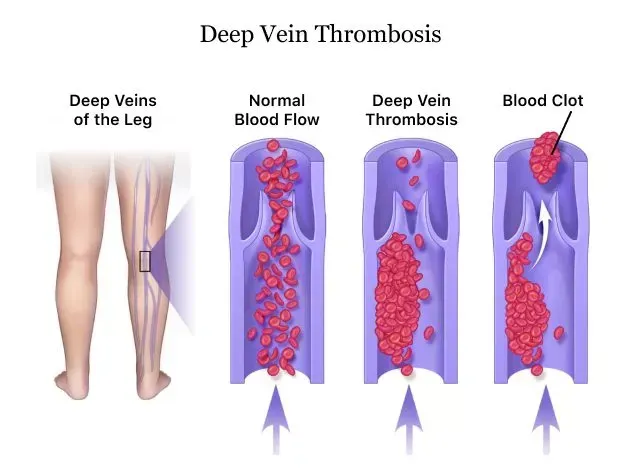Conditions Treated
Vascular Care in the Vail Valley Community
Deep Vein Thrombosis (DVT)
Acute/sub-acute Deep Vein Thrombosis (DVT) is a serious medical condition characterized by the formation of blood clots in the deep and superficial veins, typically in the legs. This condition can lead to pain, swelling, and, if left untreated, severe complications such as pulmonary embolism or blood clots which travel to the lungs. Diagnosis often involves imaging studies like ultrasound, and treatment aims to prevent clot extension and reduce the risk of embolization through clot and thrombus removal. More importantly, effective treatment of DVT can reduce the risk of Post-Thrombotic Syndrome, characterized by chronic swelling, a persistent sensation of heaviness, pain and skin ulceration, often occurring decades after the initial DVT.
Anticoagulant medications or blood thinners are commonly prescribed to prevent further clot formation. In some cases, interventions using catheters, wires, or clot retrieval devices may be employed to dissolve or remove the clot directly. Prompt diagnosis and appropriate treatment are critical in managing Deep Vein Thrombosis and preventing potential complications.

Venous Stasis Ulceration
Venous Stasis Ulceration is a chronic condition resulting from venous insufficiency, where impaired blood flow in the veins leads to increased pressure in the lower extremities. This elevated pressure can cause damage to the skin and underlying tissues, ultimately leading to the development of open sores or ulcers. Venous stasis ulcers commonly occur around the ankles and lower legs and are characterized by persistent, non-healing wounds.
Treatment involves addressing the underlying venous insufficiency through methods such as compression therapy, wound care, and, in some cases, minimally invasive procedures like endovenous ablation to improve blood circulation. A multidisciplinary approach is crucial for managing Venous Stasis Ulceration effectively and promoting wound healing.
Chronic Venous Disease
Chronic Venous Disease (CVD) is a complex vascular condition that encompasses a spectrum of disorders affecting the venous system. Our vascular medical website is dedicated to providing comprehensive insights into the diagnosis and treatment of CVD.
From varicose veins to more advanced manifestations like venous ulcers, our vascular specialists employ a tailored approach that may include minimally invasive procedures such as endovenous ablation, sclerotherapy, or micro phlebectomy. By addressing the underlying causes and symptoms of CVD, our goal is to enhance overall vascular health, improve quality of life, and prevent the progression of this chronic condition.
Spider Veins (Telangiectasias)
Spider veins, also known as telangiectasia, are small, dilated blood vessels that appear close to the surface of the skin, resembling a spider's web or tree branches. These unsightly red, blue, or purple clusters commonly occur on the legs, face, or other areas and are often associated with aging, genetics, sun exposure, hormonal changes or venous insufficiency. While usually harmless, spider veins can cause discomfort or cosmetic concerns.
Non-invasive treatments such as sclerotherapy are commonly employed to reduce or eliminate the appearance of spider veins, restoring both the aesthetic and vascular health of affected individuals. Early intervention can prevent the progression of these veins and enhance overall skin appearance and resolve bothersome symptoms.
Varicose Veins
Varicose veins are enlarged, twisted veins that often appear on the legs and result from a failure of the one-way valves within the veins, causing blood to pool and the vessels to swell. Commonly characterized by a bulging, rope-like appearance, varicose veins may cause discomfort, pain, or aching sensations. Factors such as genetics, age, pregnancy, and prolonged periods of standing can contribute to venous insufficiency.
Various minimally invasive treatments, such as radiofrequency ablation, Varithena therapy or localized removal through a series of tiny incisions, offer effective options for addressing varicose veins, relieving symptoms and improving the overall vascular health of individuals. Early diagnosis and intervention are crucial for preventing potential complications.
Venous Insufficiency
Venous insufficiency is a chronic condition, often occurring due to damaged or weakened valves within the veins of the lower extremities which inhibits blood return from the legs to the heart. Pooling of blood in the legs can lead to symptoms like leg swelling, aching, cramping, and a sensation of heaviness which can have significant impact on quality of life. In more advanced cases, patients may develop skin discoloration, varicose veins, lymphedema and venous ulceration.
Common risk factors include aging, prolonged standing or sitting, pregnancy, obesity, and a family history of venous disease. Left untreated, venous insufficiency can continue to evolve, potentially increasing the risk of more significant complications.
Diagnosis typically involves a comprehensive clinical examination and imaging studies like duplex ultrasound. Treatment options range from lifestyle modifications and compression therapy to minimally invasive procedures such as radiofrequency ablation (RFA), Varithena foam injection therapy, sclerotherapy or localized surgical microphlebectomy. Early detection and intervention are crucial to manage symptoms and prevent disease progression effectively.
Peripheral Arterial Disease
Peripheral Arterial Disease (PAD) is a vascular condition that impact blood vessels outside the heart and brain. In PAD, narrowed arteries can lead to reduced blood flow to the limbs, causing symptoms like leg pain and cramping. Treatments may involve lifestyle changes, medications, angioplasty, or surgical procedures.
Our vascular specialists focus on personalized care, utilizing advanced diagnostic and therapeutic approaches to ensure optimal outcomes for individuals dealing with these peripheral vascular conditions. Explore our commitment to comprehensive care, where cutting-edge interventions meet patient-centric solutions for Peripheral Arterial Disease.
Office Address:
1140 Edwards Village Blvd. B204
Edwards, CO 81632-5562
Mailing Address:
1300 N. Frontage Rd. W. #4994
Vail, CO 81657-9998
All Rights Reserved | Ascent Vascular Specialists and Vein Center
Website Design by Infinity Medical Marketing | Privacy Policy

